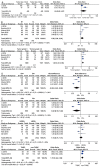Expression of PD-L1 and prognosis in breast cancer: a meta-analysis
- PMID: 28430626
- PMCID: PMC5458212
- DOI: 10.18632/oncotarget.15532
Expression of PD-L1 and prognosis in breast cancer: a meta-analysis
Abstract
The associations between programmed cell death ligand 1 (PD-L1) and the prognosis of various cancers have always been a research topic of considerable interest. However, the prognostic value of PD-L1 in breast cancer patients remains a controversial subject. We aimed to assess the association between PD-L1 protein expression and clinicopathological features and the impact of this relationship on breast cancer survival. We performed a systematic search of the PubMed, EMBASE, and Cochrane Library databases to determine the correlations among PD-L1 expression, clinicopathological features and overall survival (OS). A total of 5 studies containing 2,546 cases were included in the analysis. The combined hazard ratio (HR) and its 95% confidence interval (CI) for OS were 1.76 (95% CI 1.09-2.82; P=0.02) for patients with tumors exhibiting PD-L1 overexpression. The pooled odds ratios (ORs) indicated that PD-L1 expression was associated with positive lymph node metastasis, higher histological grades, estrogen receptor (ER)-negativity, and triple-negative breast cancer (TNBC). Our findings indicate that PD-L1 expression is a promising biomarker for the prognosis of breast cancer, and may be helpful to clinicians aiming to select the appropriate immunotherapy for breast cancer.
Keywords: breast cancer; meta-analysis; prognosis; programed death-ligand 1.
Conflict of interest statement
No potential conflicts of interest were disclosed.
Figures




Similar articles
-
Clinicopathological and prognostic significance of programmed death ligand-1 expression in breast cancer: a meta-analysis.BMC Cancer. 2017 Oct 17;17(1):690. doi: 10.1186/s12885-017-3670-1. BMC Cancer. 2017. PMID: 29041905 Free PMC article.
-
PD-L1 expression and tumor infiltrating PD-1+ lymphocytes associated with outcome in HER2+ breast cancer patients.Breast Cancer Res Treat. 2017 Feb;162(1):19-30. doi: 10.1007/s10549-016-4095-2. Epub 2017 Jan 5. Breast Cancer Res Treat. 2017. PMID: 28058578
-
The clinicopathological and prognostic significance of PD-L1 expression in gastric cancer: a meta-analysis of 10 studies with 1,901 patients.Sci Rep. 2016 Nov 28;6:37933. doi: 10.1038/srep37933. Sci Rep. 2016. PMID: 27892511 Free PMC article.
-
Prognostic Implications of PD-L1 Expression in Breast Cancer: Systematic Review and Meta-analysis of Immunohistochemistry and Pooled Analysis of Transcriptomic Data.Clin Cancer Res. 2019 Sep 15;25(18):5717-5726. doi: 10.1158/1078-0432.CCR-19-1131. Epub 2019 Jun 21. Clin Cancer Res. 2019. PMID: 31227501
-
Prognostic and clinicopathological value of PD-L1 expression in primary breast cancer: a meta-analysis.Breast Cancer Res Treat. 2019 Nov;178(1):17-33. doi: 10.1007/s10549-019-05371-0. Epub 2019 Jul 29. Breast Cancer Res Treat. 2019. PMID: 31359214 Review.
Cited by
-
Invasive Breast Carcinoma of No Special Type with Medullary Pattern: Morphological and Immunohistochemical Features.Turk Patoloji Derg. 2022;38(3):205-212. doi: 10.5146/tjpath.2021.01559. Turk Patoloji Derg. 2022. PMID: 34636027 Free PMC article.
-
Intratumoral, rather than stromal, CD8+ T cells could be a potential negative prognostic marker in invasive breast cancer patients.Transl Oncol. 2019 Mar;12(3):585-595. doi: 10.1016/j.tranon.2018.12.005. Epub 2019 Jan 22. Transl Oncol. 2019. PMID: 30682679 Free PMC article.
-
Oncolytic poxvirus CF33-hNIS-ΔF14.5 favorably modulates tumor immune microenvironment and works synergistically with anti-PD-L1 antibody in a triple-negative breast cancer model.Oncoimmunology. 2020 Feb 24;9(1):1729300. doi: 10.1080/2162402X.2020.1729300. eCollection 2020. Oncoimmunology. 2020. PMID: 32158622 Free PMC article.
-
Genetic, transcriptional and post-translational regulation of the programmed death protein ligand 1 in cancer: biology and clinical correlations.Oncogene. 2018 Aug;37(34):4639-4661. doi: 10.1038/s41388-018-0303-3. Epub 2018 May 16. Oncogene. 2018. PMID: 29765155 Free PMC article. Review.
-
Prognostic value of PD-L1 in esophageal squamous cell carcinoma: a meta-analysis.Oncotarget. 2017 Dec 27;9(17):13920-13933. doi: 10.18632/oncotarget.23810. eCollection 2018 Mar 2. Oncotarget. 2017. PMID: 29568405 Free PMC article.
References
-
- Siegel RL, Miller KD, Jemal A. Cancer statistics, 2016. CA Cancer J Clin. 2016;66:7–30. - PubMed
-
- Breast Early, Cancer Trialists’ Collaborative Group (EBCTCG) Effects of chemotherapy and hormonal therapy for early breast cancer on recurrence and 15-year survival: an overview of the randomised trials. Lancet. 2005;365:1687–1717. - PubMed
-
- Gradishar WJ, Anderson BO, Balassanian R, Blair SL, Burstein HJ, Cyr A, Elias AD, Farrar WB, Forero A, Giordano SH, Goetz M, Goldstein LJ, Hudis CA, et al. Invasive Breast Cancer Version 1.2016, NCCN Clinical Practice Guidelines in Oncology. J Natl Compr Canc Netw. 2016;14:324–354. - PubMed
-
- Knappskog S, Lonning PE. P53 and its molecular basis to chemoresistance in breast cancer. Expert Opin Ther Targets. 2012;16:S23–30. - PubMed
Publication types
MeSH terms
Substances
LinkOut - more resources
Full Text Sources
Other Literature Sources
Medical
Research Materials

